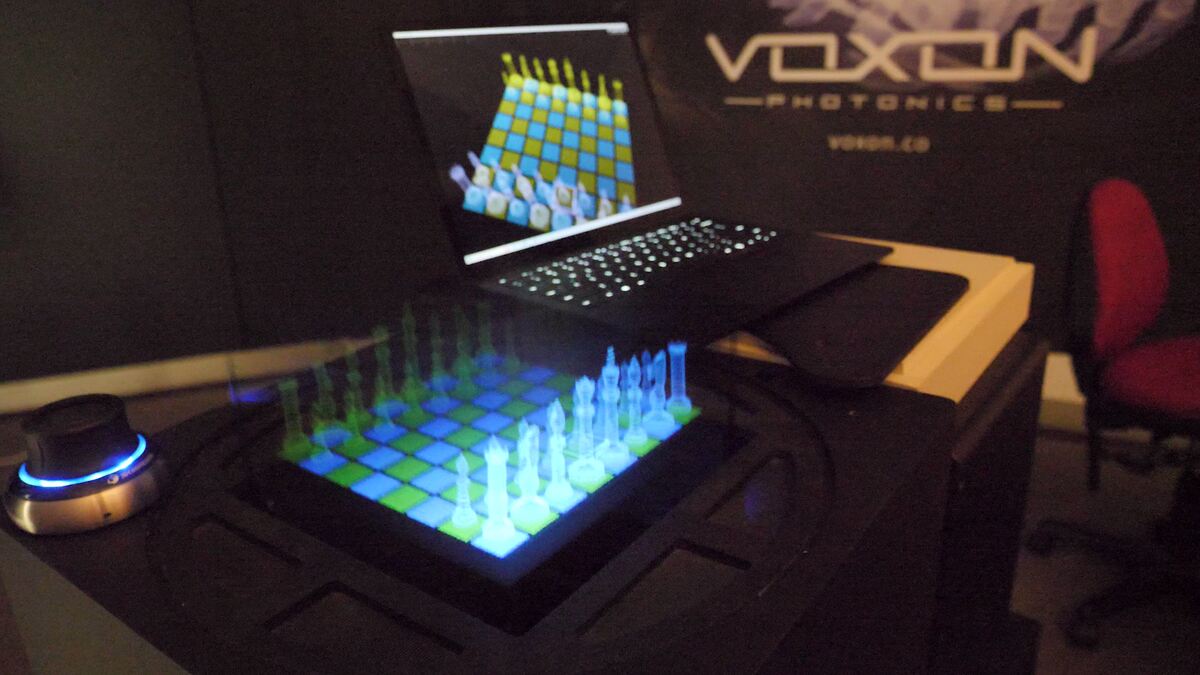Volumetric/Holographic displays are quite the feat of engineering. They can help visualize 3D models, and allowing you to view them from multiple angles, in three dimensions. This can be possibly used for seeing objects in action, such as bodily organs and their functions. It can also be used for pure communication purposes, so your subject’s face is 3d dimensional, powered by a Kinect camera, or a 3d camera in general. Of course, there are many other possible uses for these devices, but these options came to my mind first, so I listed them.
Defeats of Other Holographic/Volumetric Displays
Looking Glass
For some people, the first thing that comes to mind when someone mentions ‘holographic displays’, is the device, Looking Glass. The Looking Glass was one of the most affordable volumetric displays out there, which wasn’t just a bar of less on an oddly large spinning fan (foreshadowing…). The Looking Glass display was excellent, and had integration with Kinect cameras, the magic leap sensor, and even allowed you to add your own images/3d renders for your Looking Glass, by uploading a sequence of 45 images, or uploading a single photo, and their ai generates the 3d effect for you. Though, that’s one of the main problems—it can only be viewed from a 58-degree angle, with only 45 images! Due to this, the display has a slight blurring effect as you move your head around, with custom renders which you can see in-person. This is due to the fact that the Looking Glass software attempts to interpolate the frames, trying to produce 100 frames in total, for viewers to have a more seamless experience. As it turns out, when the software interpolates in-between the provided frames, it can sometimes create mistakes, such as ghosting or blurring. This can majorly depend on your computer, such as its computing specs, and wouldn’t entirely be the devices fault. The Looking Glass, like I said, also features a 58-degree view angle—Some people enjoy, while others complain.
‘Holographic’ Fans, or such
We have mostly heard about the rapidly spinning fans, with LED strips on the sides, which switch quickly between patterns, to form an image. These are generally cheap, and it makes a lot of sense why they are. They utilize an effect known as persistence of vision. You may already know this, but, I’ll shortly explain POV: Persistence of vision is a special ’trick’ that your brain uses to make objects’ movement more smoother by retaining the light that strikes into the retina, by around 1/10 to 1/15 of a second. This is why at certain display refresh rates, or even lights in general, don’t appear to visually flicker much or not even at all. This fan cleverly exploits this mechanism, spinning extremely fast whilst quickly changing the pattern on the LED lights. When your brain fills in the gap, it appears as streaks due to how fast it’s moving, so the lights turn different colors at precise different times, for the speaking to aid in creating the picture. Clever idea, except not so much ‘holographic’. I’d say this is alike with the Pepper’s Ghost effect, with a bright surface of light, like a screen, reflecting off a transparent film, except it gives off a feeling of being two-dimensional, whilst looking three-dimensional.
Flex LED
Utilizes the same trickery used as in holographic fans, except its smaller, needs less power to run, and doesn’t move that fast , but still creates as fairly good image. Examples of this include the Bitzee, a virtual pet, like a tamagotchi, but futurized. Again, the Bitzee is a cheap toy aimed for children, so it won’t have a too great of a resolution display, but it still shows a fairly good and cheap way of creating fake-holograms,
More Advanced Volumetric Displays
There are companies, prioritized for making these displays, such as Voxon. Voxon is a very elaborate company, creating volumetric displays. They aren’t very cheap, mainly because of the fact that they require a lot of components and effort to make, far more than your $30 holographic fans or Bitzee. These combine the same tactics the others do, persistence of vision, except, in a more different way. See, Voxon isn’t your average company, (such as the ones on amazon with the gibberish names that you always find) they have a very clear and direct purpose. Use the future technology—specifically volumetric displays—to further enhance education, entertainment, communication, medical imaging, and much more. If you take the time to think about all of the good purposes of a volumetric display, you might probably get the same ideas in mind.
Conclusion
Many volumetric and holographic devices exist as of today, sure, some of them are still a bit behind, (hinting on the fans and flex led) but they all signify a leap in technology and the future. They provide ideas, to hopefully populate more and more volumetric displays, and possibly create cheaper or better technology for display holographic images. Anyways, I love Voxon and their displays, but I also do somewhat enjoy Looking Glass, but primarily Voxon Photonic’s displays really piqued my interest, and I would LOVE to have one someday, but that I don’t quite think would be possible. Have a great day/night, and I know I’m writing to primarily nobody, because no-one views my posts anymore since not many people know about this site.

